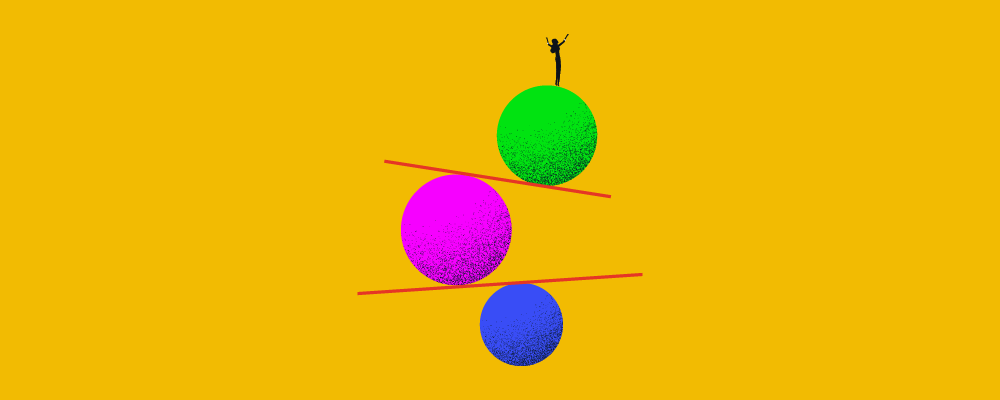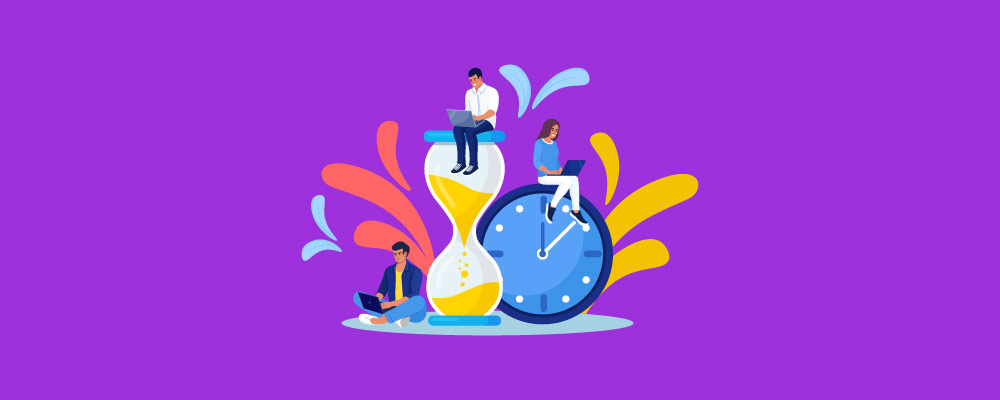Let’s start with a simple question: What is productivity? The term comes from “product,” which basically means something that’s created. But in the world of work and personal growth, productivity has grown into something much bigger.
It’s about the efficiency and effectiveness with which tasks are completed.
It’s about the balance between the quality and quantity of work, and the time and resources used to achieve it.
It’s about setting meaningful goals and making consistent progress towards them.
It’s about creating value, not just for oneself, but also for others.
So, when we chat about productivity, we’re not just talking about doing more. We’re talking about doing better and achieving more meaningful results by exploring the layers of true productivity.
The Productivity Misconception
There’s a common misconception that productivity is all about extreme efficiency. You know, the idea of completing as many tasks as possible in the shortest time.
But let’s be real, if you’re just cramming tasks into your schedule, you might end up building 100 sand castles instead of a gorgeous 4-story building.
Sure, techniques like the Pomodoro timer can help you focus on one task at a time and finish it faster. But this approach can stifle creativity and the natural flow of procrastination.
Procrastination Isn’t Always the Bad Guy
Yep, you heard it right. Procrastination isn’t always the enemy. Organizational psychologist Adam Grant suggests that a bit of procrastination can give your brain time to mull over a task or problem, leading to more creative and innovative ideas for Unlocking Your Productivity Potential.
This is the sweet spot for innovators and original thinkers.
The greatest ideas in science often hit scientists when they were not actively working on them. So, while it’s great to focus on a task to produce more output in a certain time, by procrastinating, you can actually find a shorter way to do it. Now that’s efficiency!
More Work Doesn’t Always Mean Higher Productivity
Equating productivity with extreme efficiency can lead to an overemphasis on speed and quantity, often at the expense of quality.
While it’s important to complete tasks promptly, rushing through them just to get more done can result in errors, lower quality work, and even the need to redo tasks, which ultimately undermines productivity.
Our brains are fascinating. They have the power to fool themselves into believing something. Think about the movie Inception (2010). The idea planted by the brain onto itself allows it to focus on it and ignore all other calls.
The truth is, that science still doesn’t fully understand how our thoughts work. A relaxed and open state of mind is often directly linked to the quality of the work produced.
The brain will wander off somewhere completely unrelated and will suddenly hit a eureka moment. We don’t know how it works, but we know it works.
The Role of Balance in Productivity

In our quest for productivity, we often find ourselves juggling various roles and responsibilities, both in our personal and professional lives. The key to maintaining our productivity, and indeed our sanity, lies in achieving a delicate balance.
Work-Life Balance
Work-life balance has become a buzzword in recent years and for good reason. Achieving a healthy work-life balance is not just about preventing burnout, although that’s certainly a significant factor.
It’s about creating an environment where we can be fully present, whether we’re at work or home. When we’re not constantly worrying about work during our personal time, or personal issues during our work time, we’re able to be more engaged and productive.
A good work-life balance promotes better physical and mental health and gets you a little closer to Unlocking Your Productivity Potential. When we’re healthy, we’re able to bring our best selves to our work, leading to increased productivity. And let’s not forget creativity. When we have time to relax and engage in activities we enjoy, our minds are free to come up with innovative ideas and solutions.
Work Environment Balance
Now, let’s shift our focus to the work environment itself. A balanced workload is crucial for maintaining productivity. Overworking can lead to stress and burnout, while underworking can lead to disengagement. Both scenarios can significantly decrease productivity.
But it’s not just about the quantity of work. The quality of work matters too. A balanced team dynamic, where everyone contributes equally and feels valued, can create a positive work environment that fosters productivity.
And then there’s the balance between different types of work. Mixing routine tasks with more creative or strategic ones can keep things interesting and engaging, leading to higher productivity.
Balancing Time with Breaks
It might seem counterintuitive, but taking regular breaks can actually boost productivity. Breaks prevent fatigue, keep our performance consistent, and provide opportunities for learning and socializing.
Research has shown that our brains have a limited capacity for focused attention. After a certain period of concentrated work, typically around 90-120 minutes, our ability to maintain focus begins to decline.
Taking a short break can help reset this attentional capacity, allowing us to return to our work with renewed focus and energy.
Breaks can also serve as valuable opportunities for learning and reflection. Stepping away from our work can give us a fresh perspective, helping us generate new ideas or solutions.
Breaks can also provide a much-needed respite from work-related stress, helping to prevent burnout and maintain our mental well-being.
Quality Over Quantity: The True Measure of Productivity
To understand productivity, it’s essential to challenge some deeply ingrained notions. One such idea is that productivity is about doing more in less time.
The traditional view of productivity often equates it with the number of tasks completed or the hours spent working. However, this perspective can lead to burnout, stress, and a decrease in the actual quality of work.
A study from the University of Salford found that job quality matters more for employees’ mental health than the number of hours they work.
Quality Work Saves Time in the Long Run
Quality, in this context, refers to the value, effectiveness, and relevance of the work we produce. High-quality work leads to better outcomes, greater satisfaction, and more value creation, which are the real indicators of productivity.
Consider a software developer who is tasked with writing code for a new application. If they rush through the task to complete it quickly, they might end up with a lot of bugs that need fixing later.
On the other hand, if they take their time to write clean, efficient code, the application will run smoothly, and less time will be spent on fixes and patches. The quality of work directly impacts the overall productivity.
Quality Work Paves the Way for More Quality Work
Impacting overall productivity means that the resource starts the next task with not only much more confidence but is also able to build on a strong foundation created with the previous task.
This foundation is not just about the tangible results of the previous task, but also the skills, knowledge, and experience gained during its completion.
The net result is far more efficient than it would have been if pace was prioritized. By focusing on quality, we can ensure that each task we complete contributes to our long-term productivity and success.
It’s a testament to the adage that sometimes, slower is faster. In the end, the true secret to Unlocking Your Productivity Potential is not how much we do, but how well we do it.
The Modern Workforce and Productivity
In the modern workforce, the definition of productivity is undergoing a significant transformation. Gone are the days when productivity was solely about the number of hours worked or the tasks completed. Today, the focus is shifting towards the value and impact of the work done.
The Role of Technology in Redefining Productivity
A major driver of this shift is technology. With the advent of advanced tools and platforms, employees are now able to work more efficiently and effectively.
Technology has automated routine tasks, freeing up time for employees to focus on more complex and value-adding tasks.
Moreover, technology has enabled better collaboration and communication, making it easier for teams to work together and achieve their goals.
It has also provided access to a wealth of data and insights, allowing businesses to measure productivity in more nuanced and meaningful ways.
Flexible Work Arrangements and Productivity
Flexible work arrangements allow employees to work when they are most productive. For some, this might be early in the morning, while for others, it might be late at night.
This flexibility can lead to increased productivity as employees can work at their peak performance times.
Moreover, flexible work arrangements can lead to a better work-life balance, which, as we discussed earlier, can also boost productivity.
Employees who have the flexibility to manage their work and personal responsibilities are more likely to be satisfied, engaged, and productive at work.
Redefining Productivity
As we navigate the complexities of the modern work environment, it’s clear that our traditional definition of productivity needs a revamp.
The new definition of productivity should emphasize not just the quantity of work done, but more importantly, the quality of that work.
It should account for the balance between professional responsibilities and personal well-being, recognizing that a healthy, happy individual is a productive one.
In this new paradigm, productivity is about creating value. It’s about the impact and effectiveness of our work, rather than just the output.
It’s about working smart, not just working hard. It’s about recognizing that sometimes, less is more, and that taking the time to produce high-quality work can lead to better outcomes in the long run.
Adopting this new definition of productivity can lead to healthier work habits. It can help prevent burnout, promote work-life balance, and create a more sustainable approach to work.
It can lead to better outcomes, not just for individuals, but for teams and organizations as a whole.
A Call to Shift Perspectives by Exploring the layers of true productivity
It’s time for us to shift our perspective on productivity. It’s time to move away from the outdated notion that productivity is about doing more and more and to embrace the idea that it’s about doing better.
We’ve explored the various facets of this new definition of productivity. We’ve discussed the importance of quality over quantity, the role of balance in productivity, and how the modern workforce is redefining productivity.
We’ve seen how focusing on the quality and value of work can lead to better outcomes and healthier work habits.
As we move forward, let’s keep these insights in mind. Let’s strive to be more productive, not by doing more, but by doing better.
Let’s redefine productivity, for ourselves and for our organizations. Because in the end, true productivity is about creating value, and that’s something we can all get behind.

